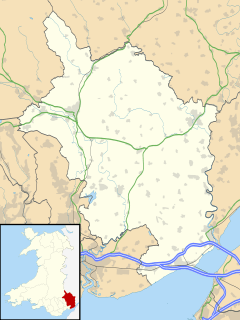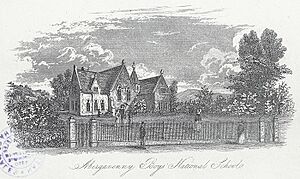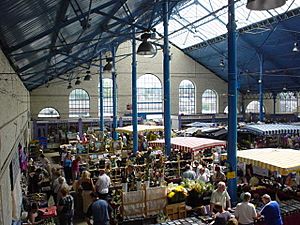Abergavenny facts for kids
Quick facts for kids Abergavenny
|
|
|---|---|
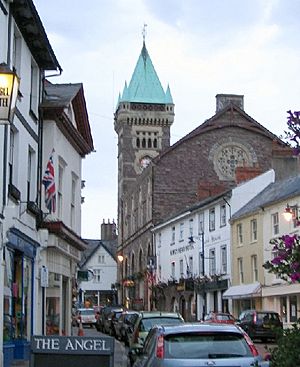 The clock tower of Abergavenny Town Hall, Cross Street |
|
| Population | 12,515 (2011) |
| OS grid reference | SO295145 |
| Community |
|
| Principal area | |
| Ceremonial county | |
| Country | Wales |
| Sovereign state | United Kingdom |
| Post town | ABERGAVENNY |
| Postcode district | NP7 |
| Dialling code | 01873 |
| Police | Gwent |
| Fire | South Wales |
| Ambulance | Welsh |
| EU Parliament | Wales |
| UK Parliament |
|
| Welsh Assembly |
|
Abergavenny (pronounced: ab-er-guh-VEN-ee) is a lively market town in Monmouthshire, Wales. Its Welsh name is Y Fenni, which means "mouth of the River Gavenny". People often call Abergavenny the "Gateway to Wales". This is because it is only about 6 miles (10 km) from the border with England. It is also where two important roads, the A40 and the A465, meet.
Long ago, Abergavenny was a Roman fort called Gobannium. Later, in the Middle Ages, it became a walled town with a strong castle. This castle was built by the Normans after they conquered Wales.
The town sits where the River Usk and the Gavenny stream join together. High mountains and hills surround it, like the Blorenge (559 m), the Sugar Loaf (596 m), and Ysgyryd Fawr (Great Skirrid). Abergavenny is also a great starting point for exploring the nearby Black Mountains and the Brecon Beacons National Park. In 2011, about 12,515 people lived in Abergavenny.
Contents
- What Does Abergavenny Mean?
- Where is Abergavenny Located?
- Abergavenny's Past: A Look Back
- Barons of Abergavenny
- Fun Events in Abergavenny
- Welsh Language in Abergavenny
- Sports in Abergavenny
- The Cattle Market
- Culture and Arts
- Getting Around Abergavenny
- Important Buildings in Abergavenny
- Parks and Green Spaces
- Town Twinning
- Military Connections
- Famous People from Abergavenny
- See also
- Images for kids
What Does Abergavenny Mean?
The name Abergavenny comes from an old word, Gobannia. This word meant "river of the blacksmiths". It shows that the town was important for making iron even before the Romans arrived. The name is linked to the Welsh word gof, which means blacksmith.
The river later became Gafenni in Welsh. So, the town's name became Abergafenni, meaning "mouth of (Aber) the Gavenny (Gafenni)". The shorter Welsh name, Y Fenni, became popular after the 15th century. The English spelling, Abergavenny, is now used most often.
Where is Abergavenny Located?
Abergavenny first grew on high ground north of the River Usk. It was also west of the smaller Gavenny River. Over time, the town spread out, even merging with a nearby settlement called Mardy. However, it remains separate from Llanfoist to the south because of the river and its flat, low-lying areas.
The land gently rises in the north of the town. Then, it gets steeper, forming parts of the Sugar Loaf mountain. The historic Usk Bridge crosses the River Usk at its narrowest point. This spot was also chosen for old tramways and later for the main railway line.
Abergavenny's Past: A Look Back
Roman Times: The Fort of Gobannium
A long time ago, around 50 CE, the Romans built a fort here called Gobannium. This fort helped guard a road along the River Usk valley. This road connected other Roman forts in the south with places further north in Wales. Gobannium also helped keep peace among the local Silures tribe. The fort was used until about 150 CE. Parts of its walls were found when building a new post office in the 1960s.
Medieval Period: Castles and Priories
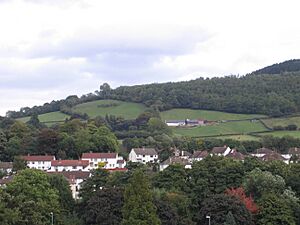
Abergavenny grew into a town during early Norman times. It was protected by the Baron of Abergavenny. The first Baron, Hamelin de Balun, founded the Benedictine priory in the late 11th century. This priory is now the Priory Church of St Mary. The church has special alabaster statues and old wooden carvings, like the "Tree of Jesse."
Because of its location, Abergavenny was often involved in border battles in the 12th and 13th centuries. In 1175, a sad event happened at Abergavenny Castle. Many Welsh leaders, including Seisyll ap Dyfnwal, were killed there by William de Braose.
Later History: Fire, Charters, and Flannel

In 1404, Owain Glyndŵr, a Welsh leader, attacked Abergavenny. Legend says his raiders got into the walled town with help from a local woman. She let them in through the Market Street gate at midnight. They opened the gate for more attackers, who then set fire to the town. They also took treasures from churches and homes. The castle was not damaged. Market Street has been called "Traitors' Lane" ever since.
In 1541, when monasteries were closed, the priory's money helped start a free school. This was the King Henry VIII Grammar School. During the English Civil War, King Charles I visited Abergavenny. He oversaw the trial of Sir Trefor Williams and other Parliament supporters.
Abergavenny was known for making Welsh flannel. It also made wigs from goat hair when they were popular. The town has held two weekly markets and three yearly fairs since the 13th century.
Modern Times: Railways and Royal Visitors
Abergavenny railway station opened in 1854. It was part of a railway line connecting Newport to Hereford. Another railway line used to go towards Brynmawr and Merthyr Tydfil. This line closed in the 1960s. Part of it is now a cycle track and footpath.
During World War II, Rudolf Hess, a German official, was kept at Maindiff Court Hospital near Abergavenny. In 1964, a small monitoring bunker was built in case of a nuclear attack. It closed in 1991.
Barons of Abergavenny
The title of Baron Abergavenny was first held by the Beauchamp family. Later, in the 14th century, the title and lands were bought by William Beauchamp. He became Baron Bergavenny. After him, the title passed to the Nevill family. In 1784, the title became an earldom. In 1876, William Nevill became the first Marquess of Abergavenny.
Coldbrook Park was a large country house near the town. It was built in the 14th century. The house was rebuilt in 1746 with a grand Georgian style. It was later taken down in 1954.
Fun Events in Abergavenny
Abergavenny hosts many exciting events throughout the year.
The National Eisteddfod of Wales is a big celebration of Welsh culture and language. It happens every August and moves to different places in Wales each year. Abergavenny hosted it in 2016 for the first time since 1913. This festival attracts around 150,000 visitors.
The Abergavenny Food Festival takes place every September. It is a popular event for food lovers. The Steam, Veteran and Vintage Rally happens every May. It features old steam engines, vintage cars, and other classic vehicles. The Abergavenny Writing Festival and the Abergavenny Arts Festival also celebrate writing and art in the town.
Welsh Language in Abergavenny
The number of people who speak Welsh in Abergavenny has grown a lot recently. In 2001, 10% of the local population spoke Welsh. This was a big increase from 2% in 1991. The town has a Welsh-medium primary school, Ysgol Gymraeg y Fenni. It also has a Welsh society and hosts a local Eisteddfod.
Sports in Abergavenny
Abergavenny has many sports clubs. Abergavenny Town F.C. is the local football club. They play at the Pen-y-pound Stadium. Abergavenny RFC is the rugby union club, founded in 1875. They play at Bailey Park, Abergavenny.
Abergavenny Hockey Club was formed in 1897. They play at the Abergavenny Leisure Centre. Abergavenny Cricket Club plays at Pen-y-Pound. They were founded in 1834. Abergavenny Tennis Club also plays at Pen-y-Pound. The town has also hosted the British National Cycling Championships several times.
The Cattle Market
A cattle market was held in Abergavenny from 1863 until December 2013. Farmers would bring their animals to be bought and sold. Before 1863, a sheep market was held in Castle Street. This was to stop sheep from being sold on the town's streets.
In 2011, plans were made to replace the market with a supermarket and library. The Welsh Government allowed this change in 2012. A new livestock centre opened in November 2013 at Bryngwyn, about 10 miles (16 km) from Abergavenny.
Culture and Arts
Abergavenny has a rich cultural history. It has hosted the National Eisteddfod of Wales three times. In 2017, the town was named one of the best places to live in Wales.
The town has local radio stations like Sunshine Radio and NH Sound. Abergavenny is also home to an award-winning brass band. This band trains young musicians.
The Borough Theatre in Abergavenny hosts many live events. These include plays, music, dance, and comedy shows. The Melville Centre also has a theatre for live events. The town's Food Festival and Arts Festival are also important cultural events.
Getting Around Abergavenny
By Train
Abergavenny railway station is on the Welsh Marches Line. This line connects Newport to Hereford. Trains run hourly between Manchester Piccadilly and Cardiff Central. Many trains continue to Swansea and west Wales. There are also trains every two hours to Holyhead in North Wales. Transport for Wales operates these services.
By Road
Abergavenny is located where the A40 trunk road and the A465 Heads of the Valleys road meet. The A465 now runs east of the town centre, making travel smoother.
By Bus
Local bus services connect Abergavenny to nearby villages. Stagecoach South Wales runs a service to Hereford and Newport. Newport Bus also operates a service to Monmouth.
Important Buildings in Abergavenny
Abergavenny Castle is just south of the town centre, overlooking the River Usk. A Norman baron built it around 1067 to protect against attacks from the Welsh. Today, you can see its defensive ditches and the ruins of its stone towers and walls. It is a very important historic building.
The Market Hall hosts many different markets. On Tuesdays, Fridays, and Saturdays, it is a retail market. Wednesdays have a flea market. There is a farmers' market on the fourth Thursday of each month. An antique fair is held on the third Sunday, and a craft fair on the second Saturday.
The Church of the Holy Trinity was built in 1840. It was first a chapel for nearby almshouses and a school. It is now a Grade II listed building.
Other important buildings include the Priory Church of St Mary. This medieval church was part of a Benedictine priory. The 16th-century Tithe Barn is also nearby. The Town Hall and parts of the old town walls are also listed buildings.
From 1851, a hospital for mental health care, called Pen-y-Fal Hospital, was on the edge of Abergavenny. After it closed in the 1990s, its buildings were turned into homes. Some mental health services are now at Maindiff Court Hospital.
Parks and Green Spaces
Abergavenny has three public parks that are listed on the Register of Parks and Gardens of Special Historic Interest in Wales. These are the grounds of Abergavenny Castle, Linda Vista Gardens, and Bailey Park. These parks offer beautiful green spaces for everyone to enjoy.
Town Twinning
Abergavenny is twinned with several towns in other countries:
Military Connections
Several soldiers from Abergavenny have been awarded the Victoria Cross, the highest military award for bravery. John Fielding and Robert Jones both received the VC for their actions at Rorke's Drift. Another soldier, Thomas Monaghan, received his VC for defending his colonel during the Indian Rebellion.
Famous People from Abergavenny
- Augustine Baker (1575–1641), a Benedictine writer.
- John Williams VC (1857–1932), a brave soldier who received the Victoria Cross.
- Scott Ellaway (born 1981), a conductor.
- Becky James (born 1991), a racing cyclist who won medals at the Olympics.
- Matthew Jay (1978–2003), a singer-songwriter.
- Peter Law (1948–2006), a politician.
- Saint David Lewis (1616–1679), a Catholic priest and martyr.
- Malcolm Nash (1945–2019), a cricketer.
- Owen Sheers (born 1974), a poet.
- Oliver Thornton (born 1979), a West End actor.
- Vulcana (Miriam Kate Williams, 1874–1946), a world-famous strongwoman.
- Ethel Lina White (1876–1944), a crime writer whose book became a famous film.
- Raymond Williams (1921–1988), an academic and writer.
- Dave Richards (born 1993), a professional footballer.
- Marina Diamandis (born 1985), a professional singer and songwriter.
See also
 In Spanish: Abergavenny para niños
In Spanish: Abergavenny para niños
Images for kids


